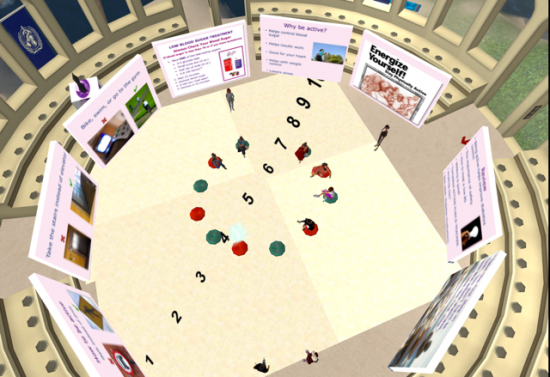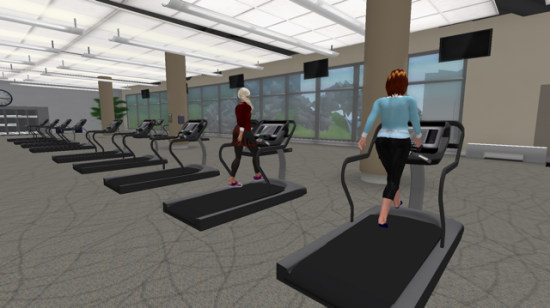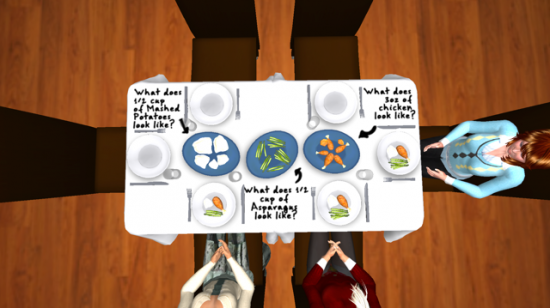Final results of the effectiveness of Boston Medical Center’s virtual diabetes training program won’t be in for a while, but one early sign is very encouraging — everyone who started the program in Second Life saw it through to the end, a dramatic improvement over face-to-face programs.

“The typical fall-off rate is very high,” said Robin Heyden, a Boston-based education consultant at Heyden Ty who helped design the program. “Many of the subjects in these studies have problems keeping the schedule of a regular weekly meeting.”
By comparison, the virtual program had “100 percent compliance,” Heyden said.
The Women in Control study is a year-long project funded by the National Institutes of Health, training 100 Black women with uncontrolled Type 2 diabetes in how to manage their health. The program was headed up by John Wiecha, director of predoctoral education in the Department of Family Medicine at the Boston University Medical School. The co-investigator was Milagros Rosal, a professor of preventative and behavioral medicine at the University of Massachusetts Medical School.
Meanwhile, inside Second Life, Heyden worked together with two other virtual program producers, Janalee Redmond (“Jennette Forager” in Second Life) and Liz Dorland (also known as “Chimera Cosmos”), who helped design activities and were present for all in-world sessions to ensure everything went smoothly.
The first session, which ended yesterday, had eight patients in the virtual group, and met for eight weeks. The next session, with 17 patients, begins next week. Patients in the virtual group in the study had to log in every week for one ninety-minute or two-hour session. Patients in the face-to-face group had to come to the Boston Medical Center.
The patients are women between 40 and 60 years old, most significantly overweight and with out-of-control blood sugar and other health problems.
“It’s very difficult for this particular population to make a steady date every week,” said Heyden. “They usually have transportation issues and extended families they’re responsible for.”

With virtual meetings, however, they can get the training from their comfort of their own home, she said.
There will be a set of medical tests for the subjects in three weeks time, to measure the effects of the intervention, she added, but there’s already some anecdotal evidence that the program had an impact.
“The environment of Second Life gave them a lot of confidence,” she said. “They felt like they were gaining computer skills. And a lot of them went in after the sessions — and would show up in a different outfit the next time.”
The participants also identified with their avatars, she said.
“There was a lot of, ‘Look what I’m doing!’ and ‘I don’t want to get wet, I don’t have a bathing suit on,'” she said.
One thing that the researchers will look at is what impact identification with the avatar has on real life behaviors.
“If I could see myself as a healthier person, making good decisions about eating, exercise and medication compliance, might I be more successful in meeting my goals?” she asked.
Unique affordances — and unique problems
The virtual setting offered some other advantages, besides convenience, but also posed its share of problems.
The way the study works is that participants are randomly assigned to meet either in Second Life or face-to-face at the Boston Medical Center. The educational materials are identical, and registered dietitian Karen Chalmers and nurse practitioner Roberta Capelson, both of Boston Medical Center, facilitated the sessions for both the Second Life and the face-to-face groups.
There were some things that virtual participants could do that the others couldn’t, however.
For example, while all virtual participants started out with realistic — overweight — avatars, many quickly learned how to change their shapes and slimmed down. Participants, who each received some Linden dollar spending money each week, also went off on their own to buy new clothing and jewelry.

Participants also engaged in physical activity in the virtual program — swimming, Tai Chi, yoga, Pilates, and more.
“We’re interested in what impact your avatar has on you,” Heyden said. “If your avatar is exercising and eating well, what impact does that have on you?”
The fact that Second Life is primarily a visual medium helped a lot, she added.
“”The women in our study have low literacy rates and very limited exposure to computers,” she said. “But because Second Life is so visual, they can leapfrog over all those literacy problems they have. There’s very little reading involved here. The processing of information is all visual and action-oriented, and there’s a whimsical, fantasy component that really appeals to them.”
Patients attend sessions on medications and on how to read food labels, but also go to a gym, a pool, and Club One’s healthy eating restaurant. (Read more about Club One here.)

“We’ve got a dancing platform on our island,” Heyden said. “One patient said, ‘I can’t dance in real life, but I sure can dance in Second Life.'”
However, some participants also struggled with technology. Each received a new laptop — an Apple MacBook — as their incentive to participate in the program, as well as a Verizon 4G wireless modem.
There were two technology training sessions — one on how to hook up and turn on the laptop, and another in how to move around in Second Life.
“One of the millions of lessons we learned in this program is that you can test the modem and the computer with Second Life and everything works great, and then they take it home,” Heyden said. “We have had some signal problems, network connectivity issues, and it has a lot to do with where they live — a lot of them live in under-served areas. One of our participants has to sit outside with her computer — it’s the only place she gets reception. She has a little porch and we had to get her an extension cord.”
As a result, a computer expert had to go out to individual homes to help solve some of these problems.
“The amount of TLC and attention for each patient is pretty high,” Heyden said. “And no, what we’re doing right now is not scalable.”
As technology evolves, however, and the platforms get easier to use, the access issue may become less of a hurdle and these kinds of programs could be rolled out to large groups, she said. “Virtual worlds are changing every minute, and the lessons we’re learning about how to deliver and execute effective virtual world instruction are going to be valuable.”
Lessons learned
The first session was deliberately kept small — just eight patients — to allow organizers to work out the kinks in the program.
“For example, we’ve dialed back the amount of information we give them about Second Life,” said Heyden. “We started out thinking — maybe we can have them building or manipulating things.”
For example, in the healthy eating restaurant, participants need to be able to take a fork into their inventory, then find it in the inventory, and put it on.
“There were a couple of activities like that, and we’ve limited that and simplified it,” she said. “Now, when we train them, we’re just showing them how to move, stand, sit, walk, and how to fly.”
It helped that the avatars were all made in advance, and the patients all received comic book-style guidebooks in their binders showing how to do things in Second Life — using actual patient and staff avatars.
Computer glitches also affected the participants more than they would experienced computer users.
“For those of us who are used to working on computers, if there’s a problem, we just log out and log back in. If there’s an update, you just do it,” she said. “But for the women in our study, the smallest technical problem sets them back because they don’t have the base of experience, the resilience to figure it out, and they’re quick to give up.”
It takes patience on the part of program staffers to help participants fix problems as they come up.
- All OpenSim stats drop on grid outages - May 15, 2024
- 3rd Rock Grid residents find new homes on ZetaWorlds - May 14, 2024
- Five things every grid needs on its home page - May 14, 2024
